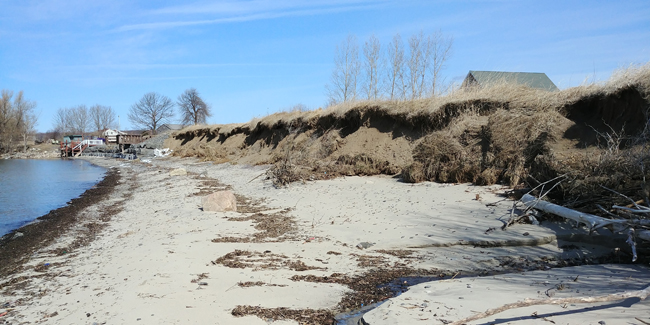
Mixture of shoreline management options on Chaumont Bay, NY. Credit: Roy Widrig, New York Sea Grant.
Contacts:
Roy Widrig, Great Lakes Coastal Processes and Hazards Specialist, New York Sea Grant, E: rlw294@cornell.edu, P: 315-312-3042
Kara Lynn Dunn, Great Lakes Freelance Publicist, NYSG, E: karalynn@gisco.net, P: 315-465-7578
Oswego, NY, April 11, 2019 - An Erosion Management for New York’s Great Lakes Shorelines guide is now available from New York Sea Grant. The 16-page guide can be downloaded for free online (pdf) or requested from New York Sea Grant at 315-312-3042.
“Erosion is a natural process and shorelines in the Great Lakes region are constantly changing shape. Developing an understanding of the natural processes at work and identifying the level of protection needed for specific sites are important considerations in planning a project,” says guide author Roy Widrig, a Coastal Hazards and Processes Specialist with New York Sea Grant, Oswego, NY.
Readers will learn about managing shoreline properties for better drainage and bluff stabilization, nature-based erosion management features such as coir logs and sills, and traditional hard or gray structures. The guide outlines the different types of each shoreline management option and discusses the design considerations, limitations, and effects on coastal processes and delicate coastal ecosystems.
Photos in the illustrated guide include shoreline management options seen along New York’s Great Lakes shoreline along Lake Ontario at:
• Irondequoit Bay in Monroe County
• Sterling in Cayuga County
• Chimney Bluffs and Sodus Bay in Wayne County
• Selkirk Shores State Park and Sandy Island Beach in Oswego County; and at
• Westcott Beach State Park and Chaumont Bay in Jefferson County.
More Info: New York Sea Grant
New York Sea Grant (NYSG), a cooperative program of Cornell University
and the State University of New York (SUNY), is one of 33 university-based
programs under the National Oceanic and Atmospheric Administration’s
National Sea Grant College Program.
Since 1971, NYSG has represented a statewide network of integrated
research, education and extension services promoting coastal community
economic vitality, environmental sustainability and citizen awareness
and understanding about the State’s marine and Great Lakes resources.
Through NYSG’s efforts, the combined talents of university scientists
and extension specialists help develop and transfer science-based
information to many coastal user groups—businesses and industries,
federal, state and local government decision-makers and agency managers,
educators, the media and the interested public.
The program maintains Great Lakes offices at Cornell University, SUNY
Buffalo, SUNY Oswego and the Wayne County Cooperative Extension office
in Newark. In the State's marine waters, NYSG has offices at Stony Brook
University in Long Island, Brooklyn College and Cornell Cooperative
Extension in NYC and Kingston in the Hudson Valley.
For updates on Sea Grant activities: www.nyseagrant.org has RSS, Facebook, Twitter, and YouTube links. NYSG offers a free e-list sign up via www.nyseagrant.org/nycoastlines for its flagship publication, NY Coastlines/Currents, which is published quarterly. Our program also produces an occasional e-newsletter,"NOAA Sea Grant's Social Media Review," via its blog, www.nyseagrant.org/blog.